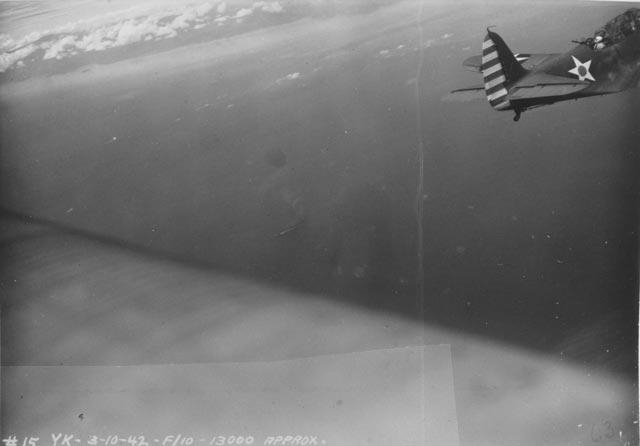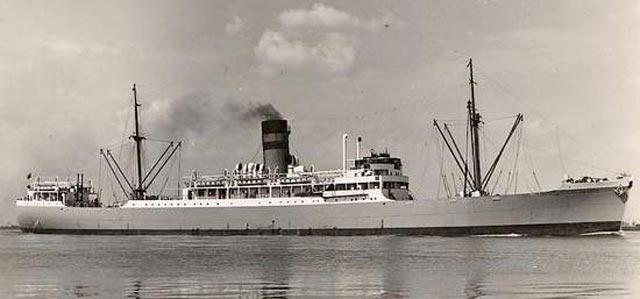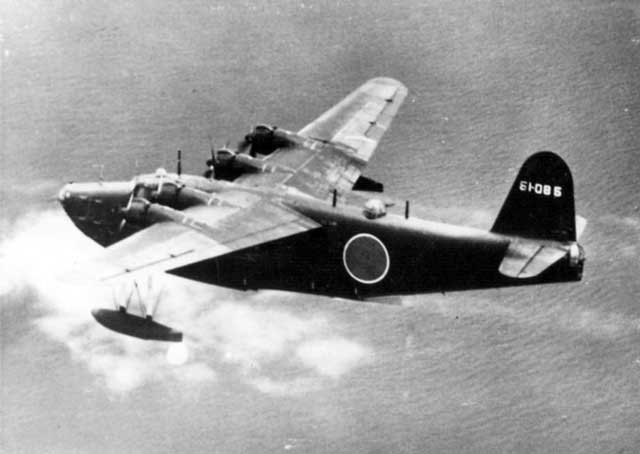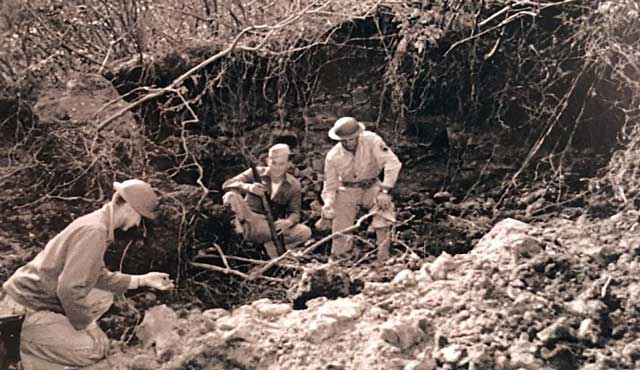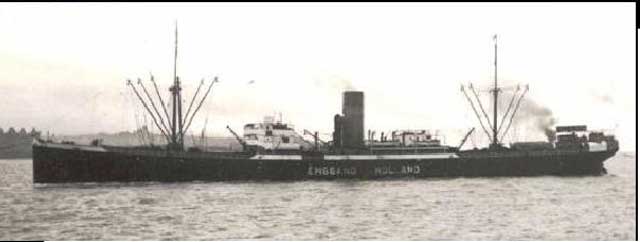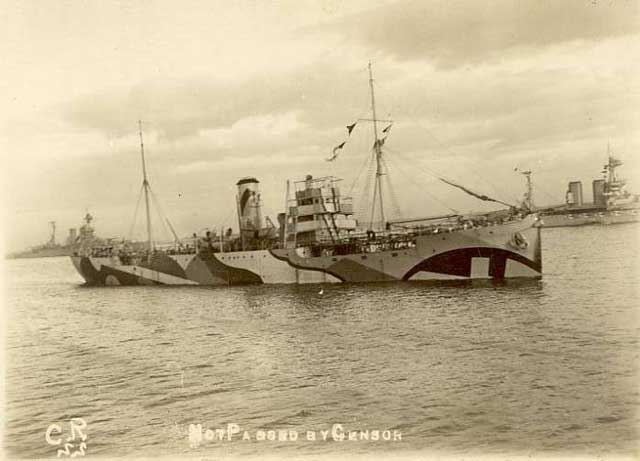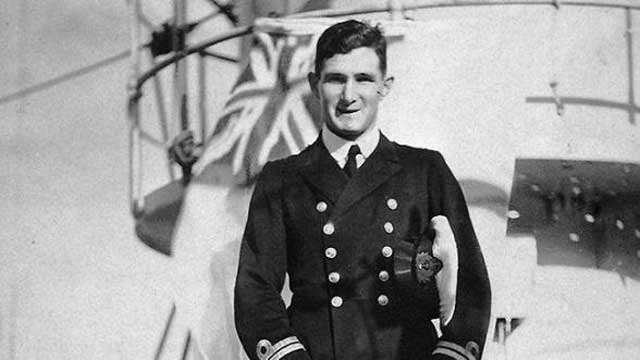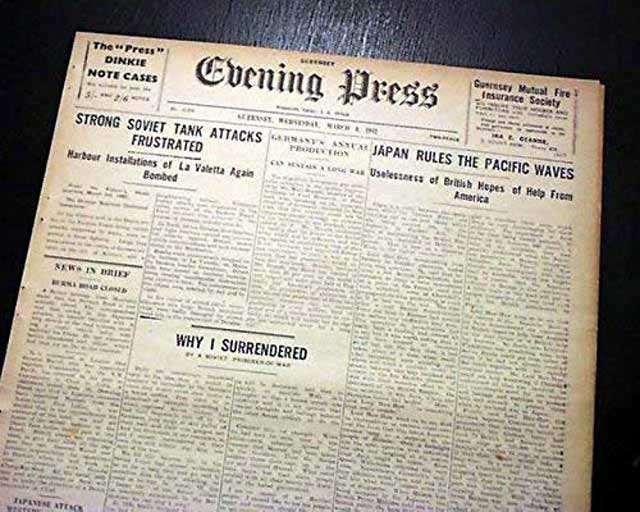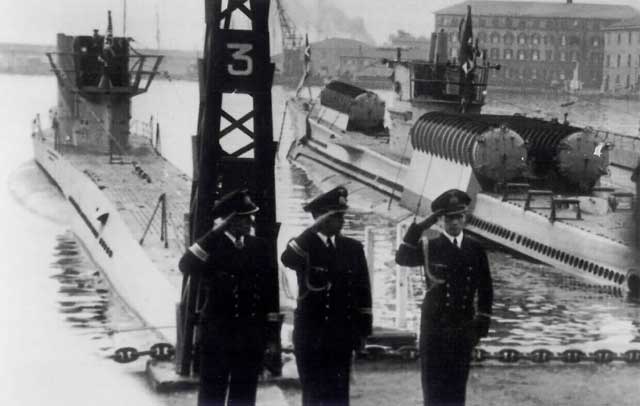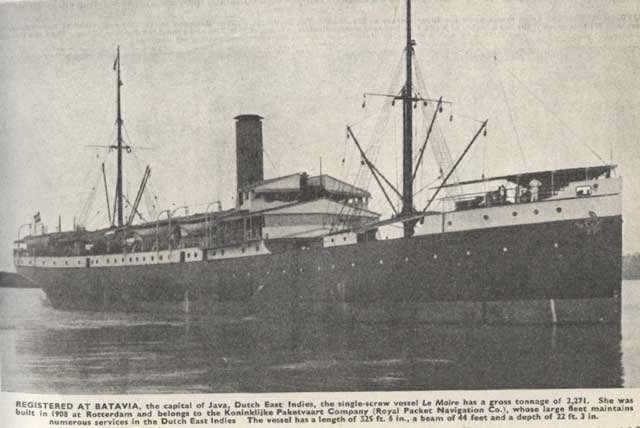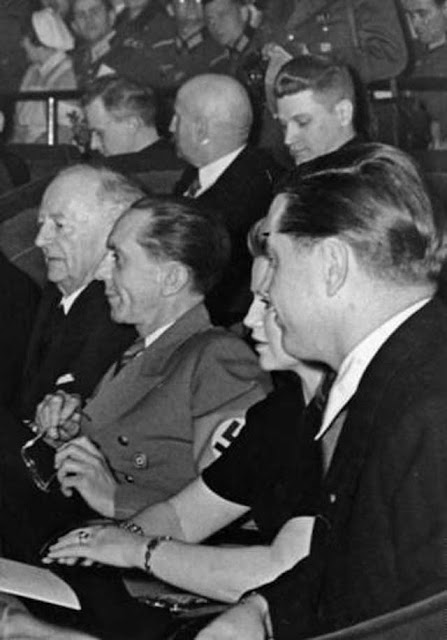Saturday 7 March 1942
 |
| Japanese troops advancing in Java, March 1942 (Sectie Militaire Geschiedenes Landmachstaf). |
Battle of the Pacific: The battle in Burma nears its end on
7 March 1942 when the Japanese send the 17th Indian Infantry Division defending Pegu on the road to Rangoon in full retreat. A counterattack by the 1st Burma Division and 7th Armored Division also fails. The new commander in Burma, General Harold Alexander, realizes that Rangoon is lost and orders the British Indian to move first to Taukkyan and then to Prome, 200 miles to the north. Alexander himself remains with local commands in the vicinity of Rangoon, which now has been completely abandoned with strategic facilities destroyed. This begins a hard-fought retrograde movement by the British Army to India which lasts for several months. Today decides the Burma Campaign.
As at other ports facing capture, the Allies scuttle any ships at Rangoon that can't escape - but most have been able to leave due to the proximity of India and the time taken by the Japanese to cross Burma. This includes 382-ton British freighter SS Nyounghla. In the coming decades, the British Army awards the battle honors Pegu and Pegu 1942 to participants.
 |
| The Arizona Daily Star for 7 March 1942 notes that "Allies Facing Exhaustion in Java Battles." Almost as interesting to the paper's readers is that "Filipinos Are Ordered to Give Up All Bolos." Bolos are knives that the locals use as both weapons and tools. |
The battle on Java also is coming to an end. Allied troops have moved to the interior of Java near Bandung. Japanese troops under Colonel Toshishige Shoji moving south from Batavia arrive at the plateau of Lembang, which is within 5 miles (8 km) of Bandung. The Allies under Major-General Jacob J. Pesman, the commander of Stafgroep Bandung, prepare to make a last stand in the hills south of the town. Other Japanese forces take the key port of Tjilatjap on the south coast, which would be the Allies' only avenue of escape. The situation is hopeless for the Allies, and they prepare to surrender.
South of Java, Japanese aircraft bomb and sink 3051-ton Norwegian freighter SS Woolgar. The crew manages to launch one lifeboat, and the crew endures an epic 88-day journey to Port Blair, Andaman Islands, where the Japanese make them prisoners. Japanese destroyer Arashio intercepts Dutch minesweepers Jan Van Amstel, which also is trying to escape Java, and sinks it. There are 23 deaths and the rest of the crew become prisoners.
 |
| German destroyers Friedrich Ihn, Hermann Schoemann and Z 25 sink Russian freighter Ishora during Operation Sportpalast on 7 March 1942. The photo is taken by V. Gernhard from Z 25. The Tirpitz, while part of the operation, was not present. |
A RAAF Hudson patrol plane of No. 32 Squadron sights a convoy of 11 Japanese ships heading for Salamaua/Lae. A Japanese invasion force lands in Northern Sumatra, with Japanese ships entering the South Andaman Sea.
Pleased with the success of the flying boat raid on Hawaii of 4 March 1942, the Japanese plan a second "K Operation" for 7 March. However, the planes and crew are not ready, so the operation is postponed to 10 March. The Americans, meanwhile, have been listening to Japanese propaganda broadcasts boasting of the raid's effects (which in reality were negligible), figure out how it was carried out, and prepare to give another such attack a hot reception.
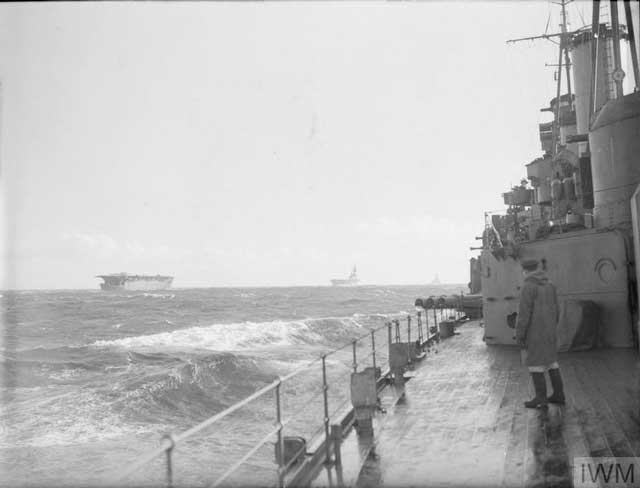 |
| "The aircraft carrier HMS ARGUS which acted as fighter escort, with HMS EAGLE (center) and the battleship HMS MALAYA (right distance) prior to flying off to Malta of the Spitfires." 7 March 1942. © IWM (A 7953). |
Eastern Front: The Luftwaffe on the Eastern Front is overstretched, and this is beginning to affect overall operations. Eighteenth Army informs the OKH that it is ready to begin Operation Raubtier ("Beast of prey"), whose aim is to re-establish the former line along the Volkhov River and thereby trap Soviet 2nd Shock Army to the west. The gap in the German lines is only about six miles wide, though the Soviet incursion bulges out to the west. Closing this gap is well within the Wehrmacht's abilities. However, the operation depends upon strong Luftwaffe support, and it is fully engaged in supplying the trapped German garrisons at Kholm and Demyansk. Knowing that the two encircled outposts cannot survive without each day's deliveries, Hitler postpones Operation Raubtier. The Eighteenth Army then tries to build up its forces sufficiently so that it can mount the operation with only minor Luftwaffe support, that but will take several days.
European Air Operations: After dark, RAF Bomber Command sends 17 bombers to attack the U-boat pens at St. Nazaire. Another 17 Hampden bombers lay mines off Lorient, another major U-boat base. One Hampden fails to return.
 |
| SS Barbara, sunk on 7 March 1942. |
Battle of the Atlantic: U-126 (Kptlt. Ernst Bauer), on its third patrol out of Lorient, torpedoes and sinks 4627-ton US freighter Barbara about 9 miles northwest of West Tortuga Island, Dominican Republic. The ship bursts into flame and the crew must jump into the sea quickly without being able to launch any lifeboats. The surviving crew clings to rafts and debris, with 16 of them, including the master and a stewardess, being picked up by a PBY Catalina flying boat (the pilot is cited for overloading his plane). Another 21 survivors make it to shore after almost three days at sea. In total, there are 26 dead and 59 survivors.
U-126 also sinks 5104-ton US freighter Cardonia in the same area. This time, Bauer uses his deck gun after the Cardonia's crew spots the U-boat sinking the Barbara and evades two torpedoes. After firing 56 rounds, the ship catches fire. After the crew abandons ship, Bauer fires a coup de grâce torpedo which sinks the ship at 12:16. Twenty of the crew make landfall in a lifeboat, while 15 others are rescued by USS Mulberry. The master, Gus Warren Darnell, is awarded the Merchant Marine Distinguished Service Medal for his evasive maneuvers and other conduct during the attack. Overall, there is one dead (in the initial attack) and 37 survivors.
U-155 (Kptlt. Adolf Cornelius Piening), on its first patrol out of Lorient, torpedoes and sinks 7874-ton Brazilian tanker Arabutan about 81 miles off Cape Hatteras. Arabutan sinks within 13 minutes. Piening claims to have seen no neutrality markings. The crew successfully launches the lifeboats and are rescued quickly by USCGC USS Calypso. There are 54 survivors and one death.
 |
| SS Uniwaleco, sunk on 7 March 1942. |
U-161 (Kptlt. Albrecht Achilles), on its second patrol out of Lorient, torpedoes and sinks 9755-ton South African tanker Uniwaleco. The first attack at 17:59 causes the ship to run out of control in circles, so a second torpedo is fired as a coup de grâce. The ship then sinks within three minutes. There are 33 survivors and 18 deaths.
U-701 (Kptlt. Horst Degen), on its second patrol out of St. Nazaire, torpedoes and sinks Danish 272-ton fishing trawler FV Nyggjaberg in the North Atlantic near Iceland. There are no survivors from the 21-man crew.
 |
| The Russian steamer Ishora is under fire from the German destroyer Hermann Schoemann in the afternoon of 7 March 1942. The photo is taken from the German destroyer Z 25 by V. Gernhard. |
Operation Sportpalast, a German sortie into the Atlantic including battleship Tirpitz, continues today. in the Arctic. German destroyers Friedrich Ihn, Hermann Schoemann and Z 25 sink Russian 2815-ton passenger ship Ijora (or Izhora or Ishora) near the Kola Inlet. Tirpitz is not present during this encounter and does not meet up with the destroyers for another 30 minutes.
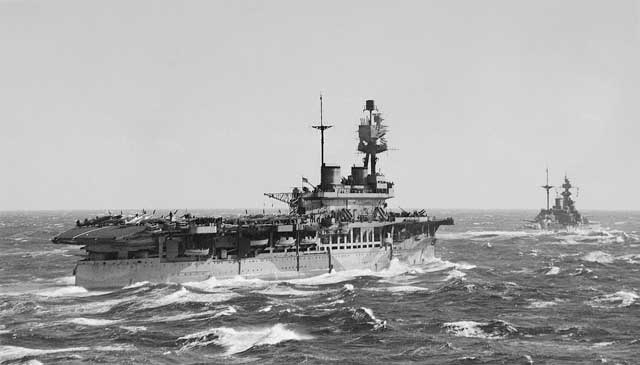 |
| "HMS EAGLE and HMS MALAYA whilst serving with Force H in the Mediterranean. Supermarine Spitfires are ranged on the deck of HMS EAGLE (photograph was taken from the aircraft carrier HMS ARGUS)." © IWM (A 7840). |
Battle of the Mediterranean: The Royal Navy sends Force H from Gibraltar on a resupply convoy to Malta. The main objective is to fly off planes from aircraft carriers HMS Argus and Eagle to the embattled garrison, which has been enduring around-the-clock air raids for many days straight. Eagle flies 15 Spitfires off which make it to the island, becoming the first Spitfires to operate there. This doubles Malta's air cover.
Applied Science: US Navy non-rigid airship K-5 conducts a successful experiment in conjunction with the submarine USS S-20 off the New London, Connecticut coast fo a radio sonobuoy. The experiment shows the utility of using sonobuoys to detect the sounds of a submerged submarine's propellers. The blimp receives the signals at a distance of up to three miles and sometimes up to five miles.
 |
| "The ship's doctor giving a lecture on first aid to crew members on HMS ATHERSTONE at Plymouth, 7 March 1942." © IWM (A 7761). |
US Military: Major General Alexander M. Patch, arrives on New Caledonia Island. He will assume command of the New Caledonia Task Force.
US Navy Patrol Wing 10 completes a three-month, roundabout withdrawal from the Philippines via Java to Perth, Western Australia. The unit has been devastated by enemy action and having to leave equipment and ground personnel behind. Three out of its four wing squadrons (VP-21, VP-22, and VP-102) are officially stricken from the order of battle. The sole remaining squadron, VP-101, will conduct patrol operations off the Australian west coast, which the Japanese Air Force recently has raided, with its PBY-4 and PBY-5 Catalinas.
 |
| "The aircraft carrier HMS ARGUS which acted as fighter escort, with HMS EAGLE (center) and the battleship HMS MALAYA (right distance) prior to flying off to Malta of the Spitfires." 7 March 1942. © IWM (A 7954). |
Headquarters, 8th Pursuit Group (Interceptor) and the 35th, 36th, and 80th Pursuit Squadrons (Interceptor) arrive at Brisbane from the United States in their P-39s.
USAAF Fifth Air Force transfers the Headquarters, 22nd Bomber Group (Medium), from Brisbane to Ipswich, Australia.
The Tuskegee flying school for black pilots graduates its first class of students. They join the 99th Pursuit Squadron. The men are Capt. Benjamin O. Davis Jr., and Second-Lieutenants Mac Ross, Charles DeBow, LR Curtis, and George Roberts.
US Government: California Representative Carl Hinshaw warns the House that a major attack on the West Coast is imminent:
Word has come to us the Japanese timetable will bring the second phase of their plans into action about April 15. This includes a major attack on Hawaii, and the commencement of sabotage action on the West Coast, in preparation for events to follow.
If our administrative officials do not get down to quick action to evacuate all Japanese and all other enemy aliens immediately — They may, by inaction, have committed so great a sin that even history may never forgive them.
There is a very real fear of a Japanese invasion all along the coast.
 |
| The New Yorker, 7 March 1942. |
American Homefront: The New Yorker for 7 March 1942 publishes a brief item (on page 7) which notes that:
We've heard from a naval officer who got promoted recently, which necessitated a reshuffling of his insignia. When his stars were removed, he found, on the back of each, a label reading "Made in Japan."
Well, times sure have changed in a hurry.
The San Francisco News continues its series of "helpful hints" to ethnic Japanese regarding their coming internment. In today's entry, the paper warns against leaving too hastily to their new homes:
General DeWitt again cautioned the aliens and Japanese-Americans against a too hasty disposition of farms, shops, residences, and other property, pointed out that Federal officials are being appointed to assist them in handling and transfer of their property. Until they have an opportunity to turn their properties over to an official custodian, such persons should not dispose of their possessions unless they receive full value in return, the general said.
There is a surreal air to these articles, which treat the evacuations as akin to a going away to summer camp with the government's sole aim to make the journey as painless and safe as possible.
 |
| The Saturday Evening Post, 7 March 1942. |
Future History: Michael Dammann Eisner is born in Mount Kisco, New York. After graduating from Denison University in 1964, he quickly becomes involved in the entertainment industry. Very early in his career, Barry Diller at ABC hires Eisner as his personal assistant. This sets Micheal Eisner on a path to success, and he joins Paramount Pictures in the 1970s when Diller becomes chairman there. Diller makes his old assistant president and CEO of the film studio, and Eisner repays the favor by greenlighting a string of classic pictures including "Star Trek" and its sequels, "Saturday Night Fever," and "Beverly Hills Cop." In 1984, Diller leaves Paramount and Eisner moves on to the Walt Disney Company, where he becomes CEO and Chairman of the Board. Eisner once again proves to have an uncanny touch at choosing good films and is largely responsible for the "Disney Renaissance" that begins with "The Little Mermaid" in 1989. Eisner leaves Disney in 2005 and goes on to other entertainment pursuits such as his own talk show on CNBC. Michael Eisner remains involved in the entertainment industry and is a legendary corporate figure.
Tamara Faye LaValley is born in International Falls, Minnesota. In 1960, Tamara (known as Tammy Faye) meets Jim Bakker and marries him a year later. Together, they form a popular televangelist organization, the PTL (Praise The Lord) Club, which takes them to heights of fame. In 1987, Jim and Tammy Faye Bakker get embroiled in scandal due to Jim Bakker's involvement with assistant Jessica Hahn. Tammy Faye divorces Bakker in 1992 after he is sent to prison for 45 years on 24 fraud and conspiracy counts. her next marriage, to property developer Roe Messner, also involves scandal when he is convicted of bankruptcy fraud. Tammy Faye Messner (her final name) passes away on 20 July 2007 from cancer.
 |
| Collier's, 7 March 1942. During World War II, Collier's readership reaches 2.5 million. |
March 1942March 1, 1942: Second Battle of Java SeaMarch 2, 1942: Huge Allied Shipping Losses at JavaMarch 3, 1942: Japan Raids Western AustraliaMarch 4, 1942: Second Raid On HawaiiMarch 5, 1942: Japan Takes BataviaMarch 6, 1942: Churchill Assaults Free SpeechMarch 7, 1942: British Defeat in BurmaMarch 8, 1942: Rangoon Falls to JapanMarch 9, 1942: Japanese Conquest of Dutch East IndiesMarch 10, 1942:US Navy attacks Japanese Landings at LaeMarch 11, 1942: Warren Buffett's First Stock TradeMarch 12, 1942: Japan Takes JavaMarch 13, 1942: Soviets Attack In Crimea Again March 14, 1942: The US Leans Toward EuropeMarch 15, 1942: Operation Raubtier BeginsMarch 16, 1942: General MacArthur Gets His RideMarch 17, 1942: MacArthur Arrives in AustraliaMarch 18, 1942: Japan Attacks In BurmaMarch 19, 1942: Soviets Encircled on the VolkhovMarch 20, 1942: "I Shall Return," Says MacArthurMarch 21, 1942: Germans Attack Toward DemyanskMarch 22, 1942: Second Battle of SirteMarch 23, 1942: Hitler's Insecurity BuildsMarch 24, 1942: Bataan BombardedMarch 25, 1942: Chinese Under Pressure in BurmaMarch 26, 1942: Win Or Die, Vows MacArthurMarch 27, 1942: The Battle of SuusariMarch 28, 1942: The St. Nazaire Commando RaidMarch 29, 1942: The Free Republic of NiasMarch 30, 1942: Japanese-Americans Off Bainbridge IslandMarch 31, 1942: Japanese Seize Christmas Island2020


